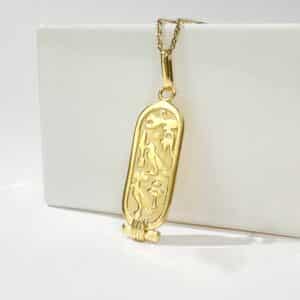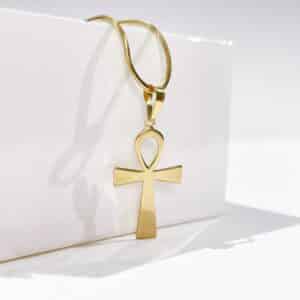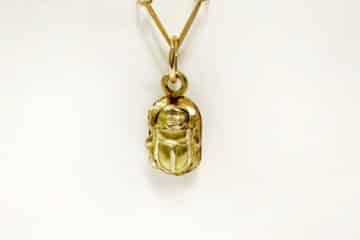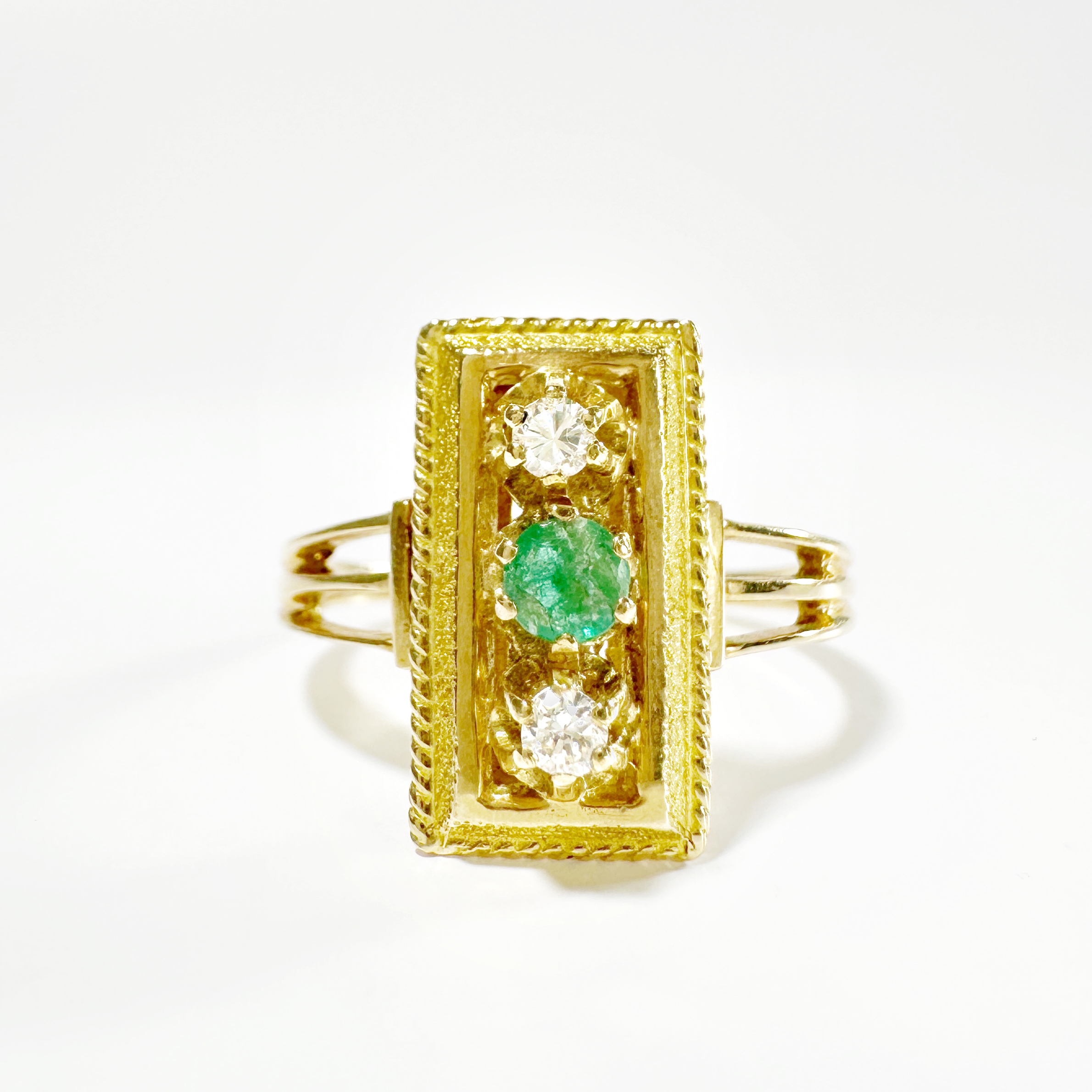You will probably have noticed that at ÓNÍSÌ PARIS we have a passion for symbolic antique and vintage jewelry. Ancient Egypt is full of motifs that are both meaningful and aesthetic, and its jewellery holds a special place in our collection. Among the many iconic symbols present in these jewellery creations, five stand out in particular: the scarab beetle, the eye of Horus, the Egyptian cartouche, the cross of Ankh and the profile of Nefertiti. Let’s explore the deeper meaning of these symbols and their importance in Egyptian jewelry.
-
The Scarab: Symbol of Regeneration and Protection
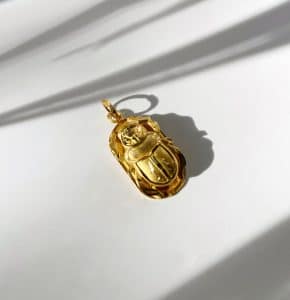 The scarab beetle, or sacred beetle, occupies a central place in Egyptian mythology and in the art of jewelry in ancient Egypt. Its depiction in the form of jewelry has a profound meaning, echoing the religious beliefs and funerary practices of this ancient civilization.
The scarab beetle, or sacred beetle, occupies a central place in Egyptian mythology and in the art of jewelry in ancient Egypt. Its depiction in the form of jewelry has a profound meaning, echoing the religious beliefs and funerary practices of this ancient civilization.
Symbolic Meaning
In ancient Egypt, the scarab was associated with the sun god, Ra, and was worshipped as a symbol of regeneration and transformation. The ancient Egyptians observed the beetle as a mysterious insect capable of rolling balls of manure, a symbol of fertility and the regeneration of life. This natural behavior led to the beetle’s association with the eternal cycle of life, death, and renewal.
Funerary use
In the funerary context, scarabs were often placed on the hearts of the deceased during embalming rituals, symbolizing protection and guidance in the afterlife. They were also used as protective amulets in tombs, believed to protect the deceased from dangers and obstacles encountered on their journey to the afterlife.
Symbolic Significance in Jewelry
Egyptian jewelry adorned with scarabs was worn not only for its aesthetics, but also for its symbolic power. Scarabs were often carved from gemstones such as lapis lazuli, turquoise, and jasper, to enhance their spiritual value and protection. These jewels were considered talismans, offering those who wore them strength, protection, and luck.
-
The Eye of Horus: Symbol of Protection and Healing
The Eye of Horus, also known as the Udjat eye, is one of the most iconic symbols of ancient Egypt. It embodies a deep meaning related to protection, healing, and spirituality, making it a recurring motif in Egyptian art and jewelry.
Symbolic Meaning
In Egyptian mythology, the Eye of Horus is associated with the deity of heaven and light, Horus, son of Isis and Osiris. According to legend, Horus lost his eye in a battle with Seth, the god of chaos, before regaining it thanks to the intervention of Thoth, the god of wisdom. The restored eye has become a symbol of healing, protection, and royal power.
Protection & Healing
The Eye of Horus was considered a protective talisman, capable of warding off evil and bringing health and well-being to its wearer. The ancient Egyptians believed that wearing the eye of Horus could offer protection against hostile forces and disease, as well as promote physical and spiritual healing.
Symbol of Royal Power
In addition to its protective function, the Eye of Horus was also associated with royal power and clairvoyance. Pharaohs and members of Egyptian royalty were often depicted with the Eye of Horus as a symbol of their divine connection to Horus and their legitimacy to rule.
Symbolic Significance in Jewellery
Egyptian jewelry adorned with the Eye of Horus was highly prized, not only for its artistic beauty, but also for its spiritual significance. Amulets and pendants in the shape of the Eye of Horus were worn by the ancient Egyptians as talismans of protection and power, providing their wearers with a sense of security and connection with the divine.
-
The Egyptian Cartouche: Symbol of Power and Royalty
The Egyptian cartouche is a distinctive symbol of ancient Egypt, used to frame the names of kings and queens in hieroglyphics. Its use in Egyptian jewelry is a testament to its importance as a symbol of power and royalty.
Symbolic Meaning
The oval shape of the cartouche, with a horizontal line at the bottom, was intended to frame and protect the names of Egyptian rulers. It symbolized the divine protection given to the pharaoh and his legitimacy as a divinely chosen ruler. Wearing a cartouche with one’s name inscribed was a mark of status and royal affiliation.
Symbol of Power
Jewels adorned with cartouches were often worn by the elite of Egyptian society to display their power and prestige. Pharaohs and members of the royal family were frequently depicted wearing jewels adorned with their own cartouches, symbolizing their authority and divine right to rule.
In jewelry: a way to assert one’s identity
In addition to their political significance, cartouches were also used to assert individual identity. The names of the pharaohs were inscribed in cartouches to distinguish them from others and to establish their immortality in the afterlife. Personalized jewelry adorned with cartouches was therefore a powerful symbol of the wearer’s identity and strength of character.
-
The Cross of Ankh: Symbol of Eternal Life and Spirituality
The Ankh Cross, also known as the Ankh Cross or Nile Cross, is one of the most iconic symbols of ancient Egypt. It embodies a deep meaning related to eternal life, vitality and spirituality, making it a recurring motif in Egyptian art and jewelry.
Symbolic Meaning
The Ankh Cross consists of a loop surmounted by a cross, symbolizing eternal life and the continuity of existence. In Egyptian mythology, she was associated with the goddess of life, Isis, and was seen as a symbol of her power to give and preserve life. Wearing the Ankh was believed to bestow vitality and immortality on its wearer.
Symbol of Spirituality
In addition to its association with eternal life, the Ankh was also a symbol of spirituality and divine power. Egyptian priests and priestesses often wore ankhs to symbolize their connection with deities and their role as intermediaries between the material and spiritual worlds.
Protective Amulet
The Ankh was also considered a protective amulet, capable of warding off evil and ensuring the safety of its wearer. The ancient Egyptians believed that wearing an ankh could ward off negative forces and ensure a healthy and prosperous life.
-
The Head of Nefertiti: Symbol of Beauty, Grace and Feminine Power
Nefertiti’s head became an iconic symbol of ancient Egypt, representing beauty, grace, and feminine power. Its use in contemporary jewelry is a testament to its timeless appeal and impact on art and culture.
Symbolic Meaning
Nefertiti was one of the most famous queens of ancient Egypt, renowned for her beauty and intelligence. Her name means “beauty has come,” and her image, immortalized in sculptures and bas-reliefs, has become synonymous with feminine grace and perfection. Nefertiti’s head thus embodies the quintessence of feminine beauty and power in Egyptian culture.
Historical Legacy
Although the depiction of Nefertiti dates back to ancient times, its use in contemporary jewelry is relatively recent. Since its rediscovery in 1912 in the city of Amarna, Nefertiti’s head has become a global icon of art and beauty, inspiring artists and designers throughout the ages.
Symbol of Eternal Beauty
The jewels adorned with Nefertiti’s head capture the timeless elegance of this historical figure. Whether in the form of pendants, rings, or earrings, these jewels embody Nefertiti’s eternal beauty and celebrate her legacy as a symbol of femininity and power.
Expression of Art and Culture
The depiction of Nefertiti’s head in contemporary jewelry is often interpreted as a fusion between ancient art and modern fashion. Nefertiti-inspired jewelry offers wearers a connection to Egyptian history and culture, while expressing an artistic and sophisticated aesthetic.
Egyptian jewelry bearing the five iconic symbols evoked is not only an object of beauty, but also good luck charms loaded with deep meanings. Whether worn for their exquisite aesthetics or for their spiritual symbolism, these jewels continue to fascinate and inspire, connecting the present to the rich heritage of ancient Egypt.
 en
en
 Français
Français

